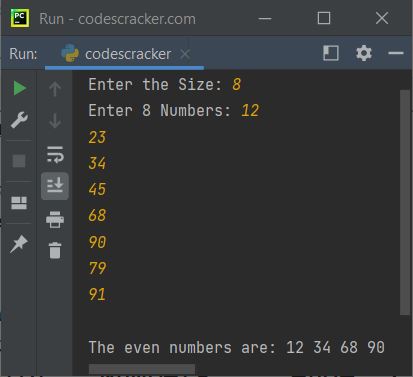- Python Basics
- Python Tutorial
- Python Applications
- Python Versions
- Python environment setup
- Python Basic Syntax
- Python end (end=)
- Python sep (sep=)
- Python Comments
- Python Identifiers
- Python Variables
- Python Operators
- Python Ternary Operator
- Python Operator Precedence
- Python Control and Decision
- Python Decision Making
- Python if elif else
- Python Loops
- Python for Loop
- Python while Loop
- Python break Statement
- Python continue Statement
- Python pass Statement
- Python break vs. continue
- Python pass vs. continue
- Python Built-in Types
- Python Data Types
- Python Lists
- Python Tuples
- Python Sets
- Python frozenset
- Python Dictionary
- List vs. Tuple vs. Dict vs. Set
- Python Numbers
- Python Strings
- Python bytes
- Python bytearray
- Python memoryview
- Python Misc Topics
- Python Functions
- Python Variable Scope
- Python Enumeration
- Python import Statement
- Python Modules
- Python operator Module
- Python os Module
- Python Date and Time
- Python Exception Handling
- Python File Handling
- Python Advanced
- Python Classes and Objects
- Python @classmethod Decorator
- Python @staticmethod Decorator
- Python Class vs. Static Method
- Python @property Decorator
- Python Keywords
- Python Keywords
- Python and
- Python or
- Python not
- Python True
- Python False
- Python None
- Python in
- Python is
- Python as
- Python with
- Python yield
- Python return
- Python del
- Python from
- Python lambda
- Python assert
- Python Built-in Functions
- Python All Built-in Functions
- Python print() Function
- Python input() Function
- Python int() Function
- Python len() Function
- Python range() Function
- Python str() Function
- Python ord() Function
- Python chr() Function
- Python read()
- Python write()
- Python open()
- Python Examples
- Python Examples
Python yield Keyword
The yield keyword in Python is similar to return, except that it returns a generator.
A generator is similar to an iterator, except that we can only iterate over once. Because generators don't store all values in the memory, rather they generate values on the fly. For example:
num = 2 mygen = (2*i for i in range(1, 11)) for x in mygen: print(x)
The output is:
2 4 6 8 10 12 14 16 18 20
which is basically the table of 2. If you try to access the elements of mygen generators again, then you'll get nothing, as generators can only be used once.
In above program, you can consider the following code:
range(1, 11)
as
[1, 2, 3, 4, 5, 6, 7, 8, 9, 10]
Just like list comprehension, the generators can be created. The only difference is, we have to use () instead of []. Also we can not perform for x in mygen for second time, since they can only be used at once.
Therefore, the following program:
mylst = [num*num for num in range(5)] for x in mylst: print(x) print("----------") for x in mylst: print(x)
produces:
0 1 4 9 16 ---------- 0 1 4 9 16
whereas the following program:
mygen = (num*num for num in range(5)) for x in mygen: print(x) print("----------") for x in mygen: print(x)
produces:
0 1 4 9 16 ----------
Now let's come back to the actual topic, the yield keyword. I've defined generator, because it is important, while talking about, yield keyword. As any function contains a yield keyword is termed as a generator.
The yield keyword is used when we need to return from a function, but without destroying the states of local variable. Also the execution must start from the last yield statement, when the function is called. For example:
def codescracker(): yield 10 yield 20 yield 30 yield 40 yield 50 for x in codescracker(): print(x)
The output is:
10 20 30 40 50
The above program can also be created in this way:
def codescracker(): for i in range(10, 51, 10): yield i for x in codescracker(): print(x)
Note - The range() function generates a sequence of numbers.
Here is the last example program, demonstrating the yield keyword in Python. This program allows user to define the size of list, along with all its numbers (elements), to find and print all even values:
def even(mylist): for val in mylist: if val%2 == 0: yield val mylist = [] print("Enter the Size: ", end="") tot = int(input()) print("Enter", tot, "Numbers: ", end="") for i in range(tot): num = int(input()) mylist.append(num) print("\nThe even numbers are: ", end="") for x in even(mylist): print(x, end=" ")
The snapshot given below shows the sample run of above program, with user input 8 as size, 12, 23, 34, 45, 68, 90, 79, 91 as eight numbers:

« Previous Tutorial Next Tutorial »